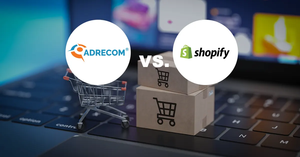
One of the most challenging lifts for your marketing department is to find customers who want to engage and then regularly interact with them. Building and fostering an online community solves that concern by giving customers a way to come to you for the conversation beyond any helpdesk needs.
When people want to talk about your products, they will. What an online community does is bring that all to you, allowing you to analyze the data, interact with fans, and solve issues before they negatively impact sales.
It is a transformation of old news releases and FAQs into a living community with a natural cycle of information, updates, and discussion. People return to it to engage not only when they have a common question, but also when they want to learn more, share something they’ve discovered, or find people with a similar passion.
Before discussing how to create and maximize your community, we should consider reasons why companies, and potential competitors, are doing this right now.
Awareness and Trust
A chief benefit of building out your own community is that you create a place for people to discuss your offer. They can ask questions, see what’s new, help each other, and make recommendations. The last element is significant because online communities are often referral hubs, and 91% of 18- to 34-year-olds trust online reviews as much as personal recommendations.
Of the people who read reviews and online recommendations, 97% read a business’s response.
Having and owning a community around your product gives you a chance to cultivate and respond to each review. You’re able to make your case to an individual, and then potential customers who are searching for you find reviews, read your team’s response, and act.
If handled well, you’re significantly closer to making a sale with someone who is seeking you out and already moving through your sales funnel.
Organic Growth
Addressing search is essential, especially when you think of the business reviews we just noted, and it is a second element where having an online community helps.
When you host and provide the forum or other online community, you’re the primary source generating content and interaction around your product or offer. You’ll become the chief place people link to when sharing questions and answers, and the place search engines rely on to get people to the information they desire.
By generating content continuously — and with a community, this means your customers are freely making marketing items for you each day — you’re boosting traditional and new SEO. Community relationships are slowly replacing keyword focuses on customers as well as search engines. When one destination meets both criteria, they get a higher value from Google and others.
The Future Is Voice
Online communities have one major advantage compared to any internal marketing your team or your partners create: they always sound like your audience. Posts, shares, discussions, and other elements will look and feel like your audience because your audience creates them. This characteristic is fundamental in the new online world.
According to Gartner, this year (2020), 30% of all web browsing will be done on devices with no screen. It’s devices like your Alexa where you ask a question and get an answer said back to you. It’s voice-only search with voice-only returns. If you factor in the estimated 15% to 25% of daily searches where people use voice assistants and don’t look at the screen for results, that’s more than half of all search this year.
Online communities matter because your customers will ask questions the same way they’d say those aloud. Other users will respond in kind. You’re naturally building up an advanced FAQ designed for voice.
You’ll be the place directly answering people’s questions and can become a trusted source as search engines try to understand how to adapt to voice-focused search.
Loyalty and Rewards
Accenture says two-thirds of customers “spend more on brands to which they are loyal,” and online communities are places where we’ve seen it grow.
In our direct experience, communities create recurring engagement and generate higher levels of consumer loyalty when those interactions are positive. It’s liked both to increased sales and higher customer lifetime values (CLV) as well as better quality leads.
Online communities can easily track elements such as posts, replies, and time on your site. These metrics allow you to evaluate loyal members and reward them directly. This already occurs on social channels — especially for retail and CPG brands — but moving it to your platform gives you greater control and data access.
Rewards programs work, and these efforts quickly pay for themselves.
Why You Want to Own Your Community
Community development and management is the process of building an online space for your customers, employees, and partners to interact. It establishes the go-to destination for news, information, and support.
Bringing this under your roof, instead of trying to manage interactions on a site like Reddit, helps companies make the most of community management. You ensure that you can collect and retain all available data, your team can act as moderators instead of relying on others to remove inappropriate content, and you don’t have restrictions on efforts designed to boost customer interactions and conversions.
The community provides additional value beyond specific products or services.
Owning the community also ensures you’re maintaining brand voice and values at all times. This helps build trust and keeps people treating you and your team like humans, while also limiting improper conduct and content. Brand voice will set you apart from other channels and help your visitors understand what to expect.
Having your community on-site also makes it easier to tie efforts to marketing goals and sales returns. You can directly A/B test efforts, run platform analytics, link user profiles to sales, and determine sentiment about changes or products to help you with future development.
When negative issues do occur, you will need to address them with your audience. By owning the online community, however, you can steer the conversation and set what information is always visible. Plus, if you have created a loyal following, you’ll have plenty of product enthusiasts who come to your defense and even help others troubleshoot any issues.
Not only can you minimize the impact of negative opinions or news, but you’ll also be cultivating a group of fans who want to help you and see you succeed.
Tips to Community Management for Success
1. Build a plan
Your key to early growth is consistency. Plan a strategy to create content and reach out to individuals within your community. A long-term approach ensures you always have something ready for your audience and that you don’t miss opportunities to highlight new products, services, or additions.
Consistent sharing and interaction also ensure that your community is a place people return to for news and information. Success comes from return visitors. Plan your content and define your roles to ensure you’ve got the right people putting out the right content at intervals your audience wants.
2. Clarify brand personality and voice
Every team member and person in your community should know what your brand is, what you stand for, and how you sound. Keep it professional and avoid insulting or harming your audience, while also finding a way to stand out from the crowd.
Your company has real people behind it, and your customers want to feel like they’re engaging with those people and not with bots. Personal communication helps your audience feel comfortable and trust you, nurturing engagement and building loyalty.
Match your brand personality to your industry. Cisco is a notable example on Twitter. Their content is always relevant and timely, while the tone is a mixture of informative and fun. Every post tells you that Cisco is there to help. Being helpful is an underlying personality you’ll find on its site, social channels, and from its support team.
3. Use the right tech stack
Accomplishing all the tasks and features we’ve noted so far requires the right mix of technology and people to manage it. You’ll need solutions designed to support users and profiles, filter content and share updates, give admins specific permissions, and utilize an architecture designed for user analytics.
Adrecom has worked with a variety of companies to trans form legacy websites into high-performing communities, and that all started with having the right tech stack. There are a variety of solutions available right now, and some will integrate with your existing CRM and marketing tools better than others.
If you have any questions, you can ask us here.
4. Actively include the audience
Once you have the system in place, you’re going to need to build out engagement. That starts with content and quickly moves to discussions.
Community members aren’t going to spontaneously talk amongst themselves as soon as you create your site. They’ll need prompts and discussions to get the ball rolling. Publish the best content you can put together that calls the audience to engage.
At the same time, you can run traditional social marketing on your own community with the goal of having users create and share their own content. This user-generated content (UGC) is seen by others as authentic and honest, driving down negative conversations and building brand loyalty.
Creating a rewards program for UGC — something as simple as recognition — will significantly boost participating and positive benefits within your community.
5. Collect and use the data you generate
We’ll leave you with one final best practice that we’ve referred to before: use the data. By owning the community and setting interactions and other elements, you’re generating a lot of information. Collect what is reasonable to learn more about your audience.
You also have plenty of opportunities to create posts, polls, and other direct interactions with customers. Your team can learn how customers want to interact and build a plan that increases your sales from there.
Hiring the right community team will allow your company to stay on top of customer concerns and uncover opportunities. It’s knowledge only you have on your customer base and market, generating a competitive advantage for you with every new post.




